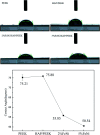Preparation and biocompatibility of Fe50Ni50p/HAP/PEEK biocomposites with weak magnetic properties
- PMID: 35520933
- PMCID: PMC9062304
- DOI: 10.1039/c9ra00719a
Preparation and biocompatibility of Fe50Ni50p/HAP/PEEK biocomposites with weak magnetic properties
Abstract
Hydroxyapatite (HAP)/polyetheretherketone (PEEK) composites are widely used in the new generation of bone implant materials. The use of weak magnetic fields can promote the biocompatibility of PEEK materials. In this paper, Fe50Ni50 alloy nanopowders and Fe50Ni50/HAP/PEEK composites were prepared by liquid phase chemical reduction and liquid phase mixing. The prepared Fe50Ni50 alloy nanopowders have a particle size of about 100 nm and good chemical activity and magnetic properties. The saturation magnetization (M s) of the Fe50Ni50 alloy powders is 70 emu g-1. Fe50Ni50 nano-powders in Fe50Ni50/HAP/PEEK composites are uniformly distributed in the matrix in the form of individual particles, achieving nano-level dispersion. With the increase of Fe50Ni50 alloy powders content, the magnetic properties of the composites are significantly enhanced. The biocompatibility of Fe50Ni50/HAP/PEEK composites is significantly better than that of PEEK and HAP/PEEK materials. The 2% Fe50Ni50/HAP/PEEK composite has the best comprehensive performance, and its biocompatibility is good. The contact angle is only 55.85°. The M s reaches 1.5 emu g-1 and the hardness reaches 42 HBa.
This journal is © The Royal Society of Chemistry.
Conflict of interest statement
There are no conflicts to declare.
Figures
















Similar articles
-
Mechanical properties and in vivo study of modified-hydroxyapatite/polyetheretherketone biocomposites.Mater Sci Eng C Mater Biol Appl. 2017 Apr 1;73:429-439. doi: 10.1016/j.msec.2016.12.076. Epub 2016 Dec 19. Mater Sci Eng C Mater Biol Appl. 2017. PMID: 28183629
-
NiCoCrFeY High Entropy Alloy Nanopowders and Their Soft Magnetic Properties.Materials (Basel). 2024 Jan 22;17(2):534. doi: 10.3390/ma17020534. Materials (Basel). 2024. PMID: 38276473 Free PMC article.
-
Toward the Production of Hydroxyapatite/Poly(Ether-Ether-Ketone) (PEEK) Biocomposites: Exploring the Physicochemical, Mechanical, Cytotoxic and Antimicrobial Properties.Polymers (Basel). 2024 Sep 5;16(17):2520. doi: 10.3390/polym16172520. Polymers (Basel). 2024. PMID: 39274153 Free PMC article.
-
Emerging marine derived nanohydroxyapatite and their composites for implant and biomedical applications.J Mech Behav Biomed Mater. 2021 Jul;119:104523. doi: 10.1016/j.jmbbm.2021.104523. Epub 2021 Apr 25. J Mech Behav Biomed Mater. 2021. PMID: 33940538 Review.
-
Nanoscale hydroxyapatite particles for bone tissue engineering.Acta Biomater. 2011 Jul;7(7):2769-81. doi: 10.1016/j.actbio.2011.03.019. Epub 2011 Apr 1. Acta Biomater. 2011. PMID: 21440094 Review.
Cited by
-
Biocompatibility and osteoinductive ability of casein phosphopeptide modified polyetheretherketone.Front Bioeng Biotechnol. 2023 Feb 8;11:1100238. doi: 10.3389/fbioe.2023.1100238. eCollection 2023. Front Bioeng Biotechnol. 2023. PMID: 36860888 Free PMC article.
-
The Surface Characterisation of Fused Filament Fabricated (FFF) 3D Printed PEEK/Hydroxyapatite Composites.Polymers (Basel). 2021 Sep 15;13(18):3117. doi: 10.3390/polym13183117. Polymers (Basel). 2021. PMID: 34578018 Free PMC article.
References
LinkOut - more resources
Full Text Sources
Miscellaneous

